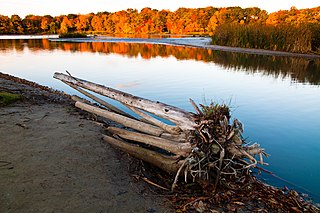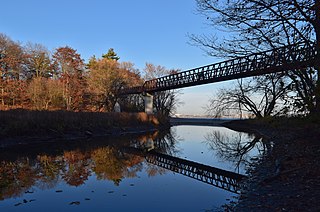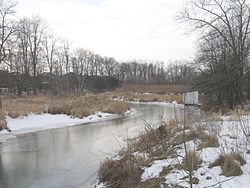
Ajax is a waterfront town in Durham Region in Southern Ontario, Canada, located in the eastern part of the Greater Toronto Area.

Pickering is a city located in Southern Ontario, Canada, immediately east of Toronto in Durham Region.

The Humber River is a river in Southern Ontario, Canada. It is in the Great Lakes Basin, is a tributary of Lake Ontario and is one of two major rivers on either side of the city of Toronto, the other being the Don River to the east. It was designated a Canadian Heritage River on September 24, 1999.

The Rouge River is a river in Markham, Pickering, Richmond Hill and Toronto in the Greater Toronto Area of Ontario, Canada. The river flows from the Oak Ridges Moraine to Lake Ontario at the eastern border of Toronto, and is the location of Rouge Park, the only national park in Canada within a municipality. At its southern end, the Rouge River is the boundary between Toronto and southwestern Pickering in the Regional Municipality of Durham.
The Toronto and Region Conservation Authority (TRCA) is a conservation authority in southern Ontario, Canada. It owns about 16,000 hectares of land in the Toronto region, and it employs more than 400 full-time employees and coordinates more than 3,000 volunteers each year. TRCA's area of jurisdiction is watershed-based and includes 3,467 square kilometres (1,339 sq mi) – 2,506 on land and 961 water-based in Lake Ontario. This area comprises nine watersheds from west to east – Etobicoke Creek, Mimico Creek, Humber River, Don River, Highland Creek, Petticoat Creek, Rouge River, Duffins Creek and Carruthers Creek.

Rouge National Urban Park is a national urban park in Ontario, Canada. The park is centred around the Rouge River and its tributaries in the Greater Toronto Area. The southern portion of the park is situated around the mouth of the river in Toronto, and extends northwards into Markham, Pickering, Uxbridge, and Whitchurch-Stouffville.

Nescopeck Creek is a 37.5-mile-long (60.4 km) tributary of the Susquehanna River in Luzerne County, Pennsylvania. The creek is in the Coal Region of Pennsylvania. The meaning of the creek's name is "deep black waters". The waters of Nescopeck Creek have difficulty ratings between Class I and Class III. However, during parts of the year, Nescopeck Creek is impossible to navigate due to rapids, flooding, and tight bends. Nescopeck Creek is home to a number of species of trout, although the waters are not always optimal for them. Nescopeck Creek's water is acidic, with a pH as low as 3.6 in some studies.
Pickering Village is a former municipality and now a neighbourhood in the town of Ajax, within the Durham Region of Ontario, Canada. The Pickering Village derives its name from the former Pickering Township, which included the present-day town of Ajax and the city of Pickering. A small portion of the original settlement is now part of the Village East neighbourhood in the city of Pickering.

Ashburn is a hamlet in the town of Whitby, Durham Region, Ontario, Canada, located approximately 15 kilometres north of the town core, and centred on the intersection of Ashburn Road and Myrtle Road. It is a rural settlement area on the Oak Ridges Moraine, situated on the headwaters of the Lynde Creek watershed and part of Ontario's protected Golden Horseshoe Greenbelt.
Greenwood is a small rural hamlet within the city of Pickering in Ontario, Canada.
Brock Road landfills are a series of landfills used by Toronto from 1975 to 1990s. The North and West site are in Pickering, while the South site is in Ajax.

Petticoat Creek is a stream in the cities of Pickering, Toronto and Markham in the Greater Toronto Area of Ontario, Canada. The creek is in the Great Lakes Basin, is a tributary of Lake Ontario, and falls under the auspices of the Toronto and Region Conservation Authority. Its watershed covers 26.77 square kilometres (10.34 sq mi), and the cumulative length of all its branches is 49 kilometres (30 mi). Land use in the watershed consists of 52% agricultural, 27% protected greenspace and 21% urban.

Duffin Creek Water Pollution Control Plant is on the north shore of Lake Ontario in the City of Pickering. It operates as a partnership between The Regional Municipality of York and The Regional Municipality of Durham. The Plant is capable of treating 630 million litres of wastewater each day and serves the communities of York Region, the Town of Ajax and the City of Pickering in Durham Region. Holding ISO 14001 certification, the Plant operates to ensure the environmentally responsible treatment of wastewater.

Heart Lake Conservation Area (HLCA) occupies 169 hectares in the Etobicoke Creek watershed, within the City of Brampton, Ontario. It is owned and managed by the Toronto and Region Conservation Authority (TRCA).
Durham Regional Council is the political body for the Regional Municipality of Durham in Ontario, Canada. Created in 1974, it consists of 29 elected representatives, including the Regional Chair. Durham Region is governed by Durham Regional Council, which consists of the mayors of the local municipalities and regional councillors directly elected in each municipality. These members are elected via double direct election. Each municipality elects the following number of regional councillors:

Lynde Creek is a stream in the municipalities of Whitby and Scugog, Regional Municipality of Durham, in the Greater Toronto Area of Ontario, Canada. It is in the Great Lakes Basin, is a tributary of Lake Ontario, and is under the auspices of the Central Lake Ontario Conservation Authority. The creek begins on the Oak Ridges Moraine in geographic Reach Township in the municipality of Scugog, and flows south to its mouth in the southwest of the town of Whitby. Portions of the 132.19-square-kilometre (51.04 sq mi) watershed also extend into the town of Ajax, the city of Pickering and the municipality of Uxbridge.

The Toronto waterway system comprises a series of natural and man-made watercourses in the Canadian city of Toronto. The city is dominated by a large river system spanning most of the city including the Don River, Etobicoke Creek, Highland Creek, Humber River, Mimico Creek and Rouge River.

Duffins Creek is a waterway in the eastern end of the Greater Toronto Area in Ontario, Canada. The watershed of the Duffins Creek is part of the Durham Region and the York Region.
Audley, known as Brown's Corners until 1857, was an unincorporated village in the Pickering Township of Ontario, Canada. In the mid-19th century, it emerged as a stopover for farmers traveling to the Whitby port, and gradually evolved into a village.
The town of Ajax, Ontario in Canada evolved out of the Defence Industries Limited Pickering Works munitions plant built during the World War II, but its history begins much earlier.















